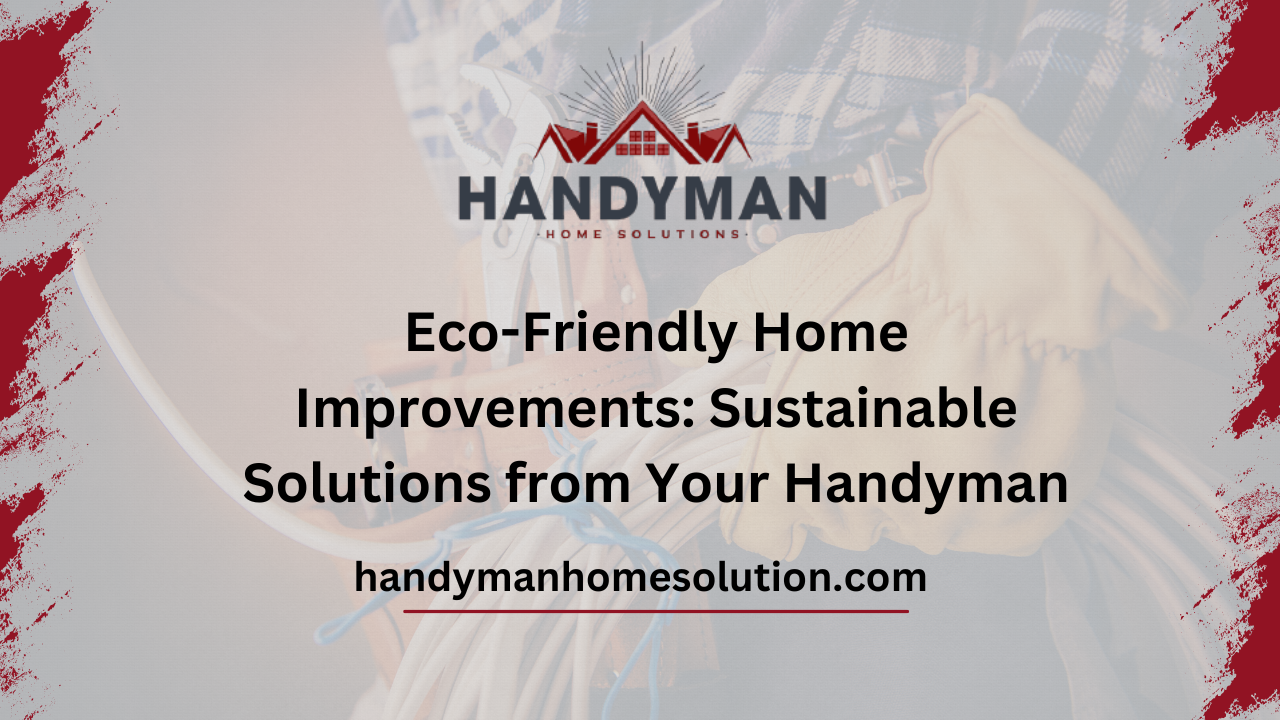Eco-Friendly Home Improvements: Sustainable Solutions from Your Handyman

Protecting Yourself: The Importance of Hiring Registered Handymen in Toms River
April 16, 2025
Spring Home Maintenance Checklist: Essential Tasks for May
May 7, 2025Key Takeaways
- Eco-friendly home upgrades cut energy bills, boost home value, and reduce your carbon footprint—all without massive renovations.
- Working with a sustainable handyman brings these improvements within reach, thanks to their knowledge and green practices.
- Tax credits and rebates make it easier (and more affordable) than ever to transition to a greener home.
Ever caught yourself sighing at a sky-high utility bill, or wishing there was a simple way to make your home feel “greener” without breaking the bank? Maybe you’ve wondered if little changes—a tightened faucet here, a new light bulb there—could actually make a real difference.
Here’s some good news: You’re not alone, and yes, they absolutely can. In fact, in 2023, 3.4 million American families saved a whopping $8.4 billion using clean energy and energy efficiency tax credits (see the coverage from the Financial Times). That’s more than loose change; it’s real money back in people’s pockets—plus the satisfaction of doing right by the planet.
What’s even better? You don’t need a six-figure renovation budget to start making a difference. Everyday sustainable handyman services are bringing eco-friendly home upgrades into reach for nearly every homeowner. Let’s dive into what that really means, why it matters, and the practical steps you can take using professional, accessible help.
Why Eco-Friendly Home Upgrades Matter
The Environmental and Community Impact
Let’s talk big picture for a moment. Our homes are more than just walls and roofs—they’re a major part of our environmental footprint. The energy you use, the water you save (or waste), and even the materials in your walls ripple outward, impacting both local communities and the world.
Green home improvements go beyond trendy design choices—they’re proven environmental game changers. Did you know that LEED-certified buildings have 34% lower CO₂ emissions, consume 25% less energy, and use 11% less water compared to standard buildings? (REsimpli, 2025) Every step you take to “green” your home lightens the load for your family and reduces stress on community resources.
Aligning with Trends and Values
And here’s the thing—it’s not just environmental activists driving the change. Sustainability is trending in the best way: The global green buildings market is set to reach a staggering $1.37 trillion by 2034 as more of us choose eco-friendly home upgrades (REsimpli, 2025).
If you’re interested in ongoing eco-upgrades that fit real life, check out Home Repairs & Maintenance. It’s all about practical solutions that match the way you actually live.
People Also Ask (PAA)
What’s the easiest way to make my home more eco-friendly?
Swapping incandescent bulbs for LEDs or sealing air leaks are two of the simplest, most cost-effective eco-friendly home upgrades. These require little upfront investment and provide lasting energy savings.
Do green home improvements really save money in the long run?
Absolutely. For example, properly insulating your attic can reduce energy bills by 10% to 50% (EcoWatch, 2023), and weatherization returns $2.69 for every dollar spent (Wikipedia, 2025).
Financial Benefits of Going Green
Energy Savings and Lower Utility Bills
Let’s get down to dollars and cents. Eco-friendly upgrades often pay for themselves—sometimes faster than you’d think. Replace leaky windows, weatherstrip drafty doors, or upgrade to modern appliances, and you’ll see the results on your next utility bill.
- Proper attic insulation alone can reduce your energy bill by 10%–50% (EcoWatch, 2023).
- Every dollar spent on weatherization (like caulking, insulation, or exterior sealing) pays back about $2.69 (Wikipedia, 2025).
Looking for actionable advice on maximizing these savings? You’ll find useful strategies on the Our Blog—from step-by-step guides to in-depth breakdowns of current incentives.
Table 1: Typical Investment vs. Annual Savings
| Upgrade Type | Typical Cost Range | Expected Annual Savings | ROI Timeline |
|---|---|---|---|
| LED Bulbs (whole house) | $100 – $200 | $75 – $150 | 1–2 years |
| Insulation (attic) | $1,000 – $2,000 | $300 – $800 | 2–3 years |
| Energy Star Fridge | $600 – $1,200 | $40 – $70 | 9–17 years |
| Weatherization | $500 – $3,500 | $150 – $450 | 2–6 years |
Savings and timelines depend on the size and current efficiency of your home.
Market Value, Incentives, and Tax Credits
Wondering if all your effort will be rewarded when it’s time to sell? Homes rated as energy efficient typically sell for 2.7% more than unrated homes; those with top ratings get a 3–5% price premium (EcoWatch, 2023).
There’s more: Thanks to the Inflation Reduction Act, you can score a 30% federal tax credit, up to $1,200 per year for renovations and an additional $2,000 for certain appliances (Time.com, 2023). That’s before you even factor in state or utility rebates.
And if you want to keep up with the newest incentives, the Our Blog spotlights current updates and how to qualify step-by-step.
How a Sustainable Handyman Can Help
What Are Sustainable Handyman Services?
Here’s where theory meets reality. A sustainable handyman doesn’t just fix what’s broken—they guide you towards green home improvements by:
- Using eco-friendly materials (think: low-VOC paints, reclaimed wood)
- Implementing water-saving plumbing solutions
- Sourcing responsibly for materials and recycling what they can
Their expert, hands-on approach means your vision for a greener home comes with less guesswork and more guaranteed results.
Access and Affordability
Maybe you want to insulate, but don’t know what type of material is best. Or perhaps you’ve dreamed of low-flow toilets, but you’re not a plumber. This is where a good handyman shines: They democratize sustainable upgrades, breaking down big projects into doable action items.
Want to know how much you can actually do? Start exploring with Handyman Services in Toms River—where small jobs can add up to big sustainability wins.
High-Impact Eco-Friendly Upgrades You Can Start Now
Energy-Efficient Lighting and Appliances
Remember the days when refrigerators buzzed non-stop? Thankfully, modern refrigerators now use 40% less energy than their 2001 counterparts (Wikipedia, 2025). Upgrading appliances, swapping out old light fixtures for LEDs, or switching to timers and motion sensors all add up.
Energy-Saving Quick Wins (Bullet List):
- Swap all incandescent bulbs for LEDs
- Install smart thermostats
- Choose Energy Star appliances whenever replacements are needed
- Use low-VOC paint for your next room refresh
- Add dimmers or motion sensors in lightly used areas
Insulation, Weatherization, and Sealing Leaks
Drafts are sneaky culprits for high energy bills. By tackling attic insulation, caulking, or even just weatherstripping, you can dramatically reduce wasted energy. And don’t forget—these are core specialties for most handymen.
- Proper attic insulation reduces energy use by 10–50% (EcoWatch, 2023), making it one of the highest ROI steps you can take.
Need help identifying hidden leaks or insulation gaps? It’s a classic “call the handyman” job: quick, affordable, and high impact.
Water Conservation and Low-Flow Solutions
Water bills creeping up? Swapping older toilets for high-efficiency models, installing aerators, or going for low-flow showerheads are simple (but mighty) home upgrades. Not only do they help the earth, but they put money back in your wallet every month.
Check out professional Plumbing Services for the best options in your region, tailored to your family’s needs.
Table 2: Water-Saving Upgrades Cheat Sheet
| Upgrade | Water Savings | Typical Install Time |
|---|---|---|
| Low-flow Toilet | 20–60% reduction* | 1 hour |
| Faucet Aerator | 30%+ reduction | 15 minutes |
| Showerhead | 50%+ reduction | 20 minutes |
*Compared to pre-1995 toilets.
Sustainable Materials and Green Construction Practices
Environmentally Friendly Building Materials
Small choices have long lives. When you upgrade or repair, consider:
- Recycled composite decking: Durable and eco-friendly
- Bamboo flooring: Fast-growing, renewable resource
- VOC-free paints: Improve indoor air quality (no more mystery headaches!)
- Reclaimed or FSC-certified wood: Converts “waste” into beautiful, sustainable finishes
These choices don’t just look good; they let you breathe easier—literally and figuratively.
Smart Project Planning for Minimal Waste
A sustainable handyman isn’t just thinking about what goes on the wall, but also about what ends up in the landfill. Efficient project planning—precision cuts, recycling materials, responsible disposal—makes a difference both to your home and to the planet.
If “waste not” is your motto, a pro can help you design projects where offcuts and scraps are minimized and recycling is the norm, not the afterthought.
Partnering with the Right Handyman for Sustainable Results
Choosing Eco-Conscious Professionals
Some handymen “walk the talk” on green practices—and choosing one comes down to a few key questions:
- Certifications or green credentials? (Ask for proof—it’s your money and your planet.)
- Testimonials from happy, eco-focused clients?
- Transparency in material sourcing?
Hiring a registered, reputable expert increases your peace of mind—and protects your investment. For more tips, see Protecting Yourself: Hiring Registered Handymen.
Customized Green Solutions for Every Home
No two homes are the same. Your handyman can recommend climate-appropriate, budget-friendly strategies that truly make sense for your life. One small fix at a time—weatherstripping today, a smart thermostat next month—your impact grows.
Remember: The sum of small actions creates big results over time.
Overcoming Common Myths & Roadblocks
Addressing Misconceptions About Cost and Complexity
Heard that going green is too expensive or confusing? Good news: That’s old thinking.
- ROI is proven—weatherization and insulation can pay for themselves in just a few years (Wikipedia).
- Government tax credits now cover up to 30% of the cost for many projects (Time.com).
Breaking Down the Project into Achievable Steps
If you’re overwhelmed, start with a single step. Here’s your Quick Start Checklist:
- Replace five most-used bulbs with LEDs.
- Schedule a home energy audit (many utilities offer these free).
- Insulate drafty windows or doors with simple weatherstripping.
- Upgrade one appliance to Energy Star-rated.
- Contact a sustainable handyman to discuss water-saving or insulation ideas.
Need help? Browse Handyman Services in Toms River and get a consultation that matches your style and budget.
Ready to Make the Green Switch?
It’s clear: Eco-friendly home upgrades are more accessible, impactful, and affordable than ever. With guidance from a local, sustainability-minded handyman, you can enjoy lower bills, a higher home value, and the warm feeling of making a difference.
Why wait? Your journey to a greener, happier home can start with a single conversation. Whether you’re ready to jump into a full insulation project or just want advice on the best showerhead, today’s the perfect day to take that first step toward sustainable living.
Ready to explore sustainable handyman services or want a personal green home improvement plan? Contact us for your customized consultation!
FAQs
1. How do I know which eco-friendly upgrade makes the most sense for my house?
Start with a home energy audit. These assessments identify the improvements with the highest ROI—like insulation, window sealing, or appliance upgrades. Many utility companies or local handymen offer audits either for free or at a low cost.
2. Will eco-friendly materials fit my home’s style?
Absolutely! Sustainable materials like bamboo flooring, recycled tiles, and low-VOC paint are available in a wide range of colors, finishes, and styles. Your handyman can help you match new green choices to your existing decor seamlessly.
3. What are the most budget-friendly green upgrades?
LED lighting, smart thermostats, faucet aerators, and weatherstripping are all upgrades that cost little but deliver outsized benefits in savings. Many can be done in just a couple of hours by a pro—or confident DIYers.
4. Are there local or state incentives beyond federal tax credits?
Yes. Many utilities and state governments offer additional rebates on insulation, windows, HVAC upgrades, and appliance replacements. A knowledgeable handyman or contractor can often guide you to available programs.
5. How can I verify that a handyman follows sustainable practices?
Ask about their material sourcing, waste disposal procedures, and any green certifications or training they’ve completed. Reputable providers should be transparent and happy to share their methods and references.




